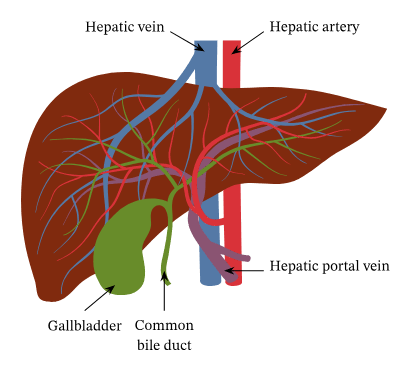The Liver
1/9
There's no tags or description
Looks like no tags are added yet.
Name | Mastery | Learn | Test | Matching | Spaced |
|---|
No study sessions yet.
10 Terms
What are the major metabolic functions of the liver
• Detoxifies harmful substances (e.g., drugs, alcohol, hormones)
• Metabolizes carbohydrates, proteins, and fats
• Produces vital substances like glucose, ketone bodies, cholesterol, and bile
• Synthesizes plasma proteins such as albumin and clotting factors
• Stores glycogen, vitamins (A, D, E, K), and minerals like iron
• Converts ammonia (toxic) into urea for safe excretion
Briefly describe the dual blood supply to the liver, mentioning the hepatic artery and hepatic portal vein
The liver receives blood from two sources:
1. Hepatic artery – supplies oxygen-rich blood from the heart
2. Hepatic portal vein – supplies nutrient-rich, oxygen-poor blood from the digestive organs
These two blood sources mix in specialized liver capillaries called sinusoids, where hepatocytes can extract nutrients and detoxify substances before blood is drained into the hepatic veins and returned to the heart.

Explain the role of hepatocytes in the liver’s overall function
• Main functional cells of the liver (~80% of liver mass)
• Extract and process nutrients from the blood
• Synthesize bile, cholesterol, albumin, and clotting proteins
• Detoxify drugs and hormones
• Store glycogen, vitamins, and minerals
• Perform gluconeogenesis (making glucose from non-carbs)
Describe the role of bile produced by the liver in digestion and waste removal
• Bile contains bile salts that emulsify fats in the small intestine for better digestion
• Aids in fat-soluble vitamin absorption (A, D, E, K)
• Carries waste products like bilirubin (from old red blood cells) and excess cholesterol
• Bile is stored in the gallbladder and released during meals
What other significant roles does the liver play in maintaining bodily homeostasis?
• Regulates acid-base balance through hydrogen ion and bicarbonate processing
• Filters bacteria and viruses from blood coming from the gut (immune defense)
• Breaks down and deactivates hormones like estrogen and cortisol
• Regulates iron and copper metabolism
• Acts as a blood reservoir to help stabilize blood pressure and volume
How does the liver contribute to maintaining stable blood glucose levels?
• Stores excess glucose as glycogen when insulin is high (after meals)
• Breaks down glycogen to release glucose when glucagon is high (during fasting)
• Produces glucose from amino acids and glycerol via gluconeogenesis
• Helps keep blood glucose in a narrow, safe range — critical for brain function
What is liver’s role in cholesterol balance withing the body?
The liver synthesizes cholesterol from acetyl-CoA, especially when dietary intake is low.
This is crucial because cholesterol is needed for:
Cell membranes
Hormone production (e.g., estrogen, testosterone)
Vitamin D synthesis
Bile acids
Liver makes VLDL (very low-density lipoproteins) → turns into LDL → delivers cholesterol to cells.
The liver has LDL receptors that remove excess LDL from the blood.
It also converts cholesterol into bile acids, which are secreted into bile and help digest fats.
Cholesterol and bile acids are excreted into the small intestine through bile.
Some are reabsorbed, but the rest is excreted in feces, which is one of the body’s few ways to eliminate cholesterol.
How does the liver-produced protein albumin help maintain blood volume?
Albumin (protein) stays in your bloodstream (it’s too big to leak out).
It pulls water into the blood vessels using something called oncotic pressure (a type of “protein pull”).
This keeps your blood volume and pressure stable, so blood can circulate properly and tissues stay hydrated.
• Maintains plasma volume and prevents fluid from leaking into tissues
• Low albumin levels (e.g., in liver disease) cause edema or ascites
• Also serves as a transport protein for hormones, drugs, and fatty acids
What is the role of transferrin in the body’s iron balance?
Transferrin is a protein made by the liver that plays a key role in iron transport:
It grabs onto iron (Fe³⁺) in the blood after it’s absorbed from food or recycled from old red blood cells.
It safely carries the iron through the bloodstream (iron is toxic if it floats around freely).
It delivers iron to places that need it — especially the bone marrow (to make new red blood cells) and liver or spleen for storage.
By regulating how much iron is available, it helps maintain iron balance and prevents both deficiency and overload.
Explain the functions of ferroportin and hepcidin in regulating iron levels
• Ferroportin is the only known protein that allows iron to exit cells into the bloodstream
• Found on gut cells (iron absorption), spleen macrophages (iron recycling), and liver cells (iron release)
• Hepcidin, made by the liver, binds to ferroportin and degrades it
• High iron → more hepcidin → ferroportin blocked → less iron enters blood
• Low iron → less hepcidin → ferroportin active → more iron enters blood
• This forms a negative feedback loop to maintain stable blood iron levels